11 Store-Bought Jarred Pesto Brands, Ranked
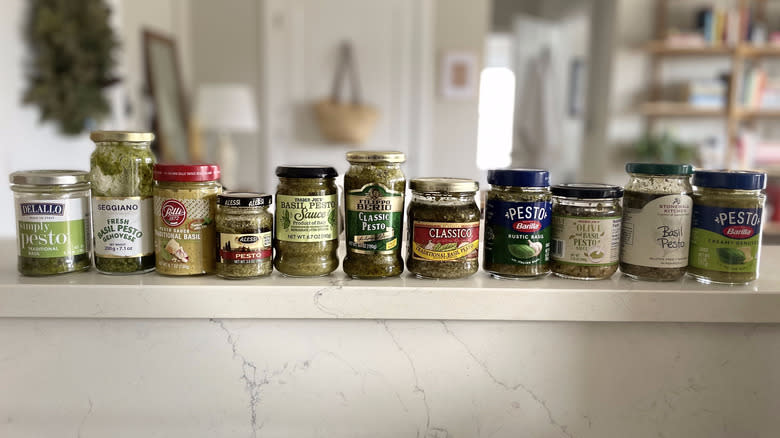
In the heat of summer, a well-nourished basil plant can yield quite a bounty of leaves. But, this tender green doesn't keep easily. Inevitably, home cooks devised an economical solution to make this herb shelf-stable, and pesto was born.
Pesto's ancient origins began in Liguria, a region in the northwesternmost part of Italy. Its capital city, Genoa, is the home of aptly named Genovese pesto, but you can also find it on restaurant menus and in grocery store sauce aisles worldwide. The original Genovese sauce combined fresh herbs with cheese, oil, and salt in a mortar to create a thick, herb-forward flavor — and it's clear that the emphasis on herbaceous, punchy ingredients hasn't changed with time.
Unless you're one of those wise cooks-slash-gardeners who prepares a surplus of basil to freeze for wintertime pesto, you likely have to purchase a jarred version to make up the difference. To ensure you get the best product, we ranked popular store-bought versions of the classic basil pesto based on factors like quality, flavor, texture, and overall value.
Read more: 26 Types Of Pasta Sauce Explained
11. Classico Traditional Basil Pesto
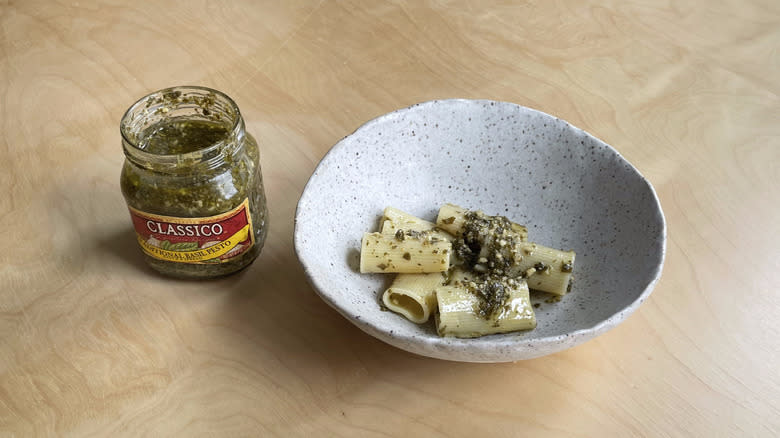
It's difficult not to have a Proustian moment here: This pesto brand was molto classico in '90s households. Once you unscrew the cap, you may be greeted by memories of your mother judiciously applying a tablespoon of this oily condiment to a whole pot of pasta, expecting it to cover the entire pot of noodles. We now know that the secret to a creamy pesto sauce is mixing the herby base with a bit of pasta cooking liquid, then vigorously stirring it. But this trick doesn't work so well on Classico -- a somewhat dishonorable facsimile of pesto as we know and love.
The recipe here is anything but classic. For starters, olive oil is bulked out with cheap soybean oil, which is understandable given this product's low price. But it's the woodsy, musty aroma from the basil — like that of a dried herb -- that makes us long for bright and fresh homemade pesto. This product also has a sour, tinny flavor from the citric acid preservative -- which is odd considering how oxidized and muddy the color of this pesto is anyway. The minced garlic and cheese taste pickled, and the piecemeal texture from these ingredients makes the sauce unnecessarily gritty. The only virtuous quality of this pesto is that it's nut-free, which makes it a good option for folks with allergies.
10. Trader Joe's Olive And Basil Pesto
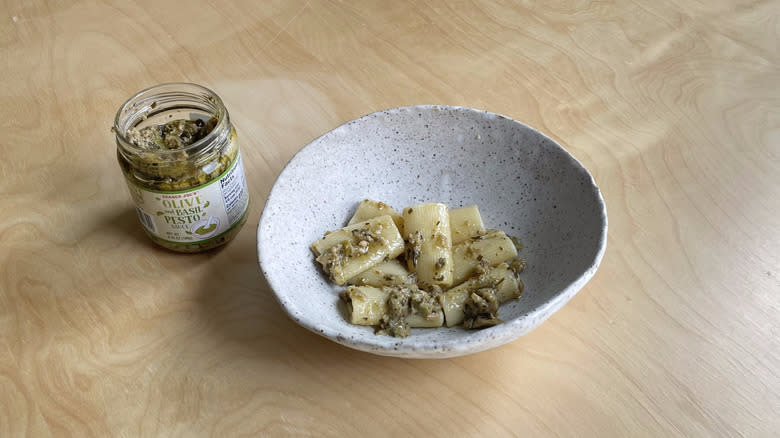
We realize it's almost unfair to include a bracing co-ingredient like olives in this basil pesto lineup. But Trader Joe's is known for reinventing a simple sauce 10 times over. It'd be wrong to evaluate this brand without including one of its new-age pesto hybrids.
The question we find ourselves asking, then, is whether Trader Joe's olive and basil version is a tapenade masquerading as a pesto. Nothing is revealed after the first bite since the brininess is reminiscent of other brands we tried, but a quick peek at the back label gives us our answer. This pesto is primarily made with green olives, and thus, if you are a basil lover but an olive hater, you'd be wise to skip it. This concoction's only "pesto" quality comes from actual dried, not fresh, basil leaves, which are also this sauce's Achilles heel. Dried basil tends to taste musty, and there aren't any other redeeming qualities in this jar — no imported cheeses or "exclusively made with pine nuts" claims to justify tolerating this product.
Three types of nuts are featured (almonds, pine nuts, and walnuts), but they are hardly detectable in either flavor or texture. The briny, acidic flavor we encountered with other low-quality brands was present, which made us think that an entire bowl of this sauce would be overwhelming. Though, the low price of this product is certainly a draw.
9. Stonewall Kitchen Basil Pesto
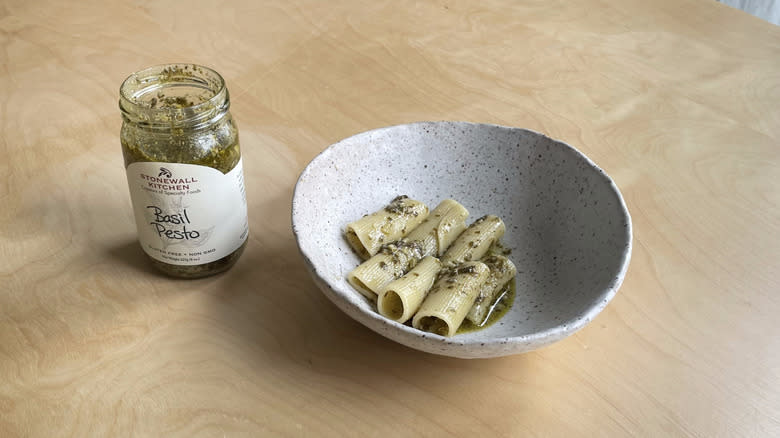
Yes, this brand may have a farmers market origin story, and yes, they hail from Maine, so we want to love Stonewall Kitchen right down to the Bean boot. While the brand might have started with bunches of fresh basil beside hand-labeled jars, it has gotten much, much bigger. After all, we caught Stonewall Kitchen merchandised on the shelf alongside other big-box brands, like Alessi, Filippo Berio, and Barilla.
Still, the New England aesthetic of the jar has us dreaming of digging into a big bowl of pesto-topped pasta while we watch the summer days wane over the lake. In short, we can appreciate having a domestically produced product, as most of the pestos on this list are made from imported ingredients. But when the primary fat here is canola -- not olive -- oil, you miss out on the fruity, grassy, and flavorful qualities that make pesto a beloved sauce. And is pesto sauce not simply an excuse to dress your pasta with lashings of olive oil? Equally non-traditional is lemon juice, which gives Stonewall Kitchen's pesto a sour flavor that taints the herbaceousness of the basil. It's not very Ligurian.
8. Barilla Rustic Basil Pesto
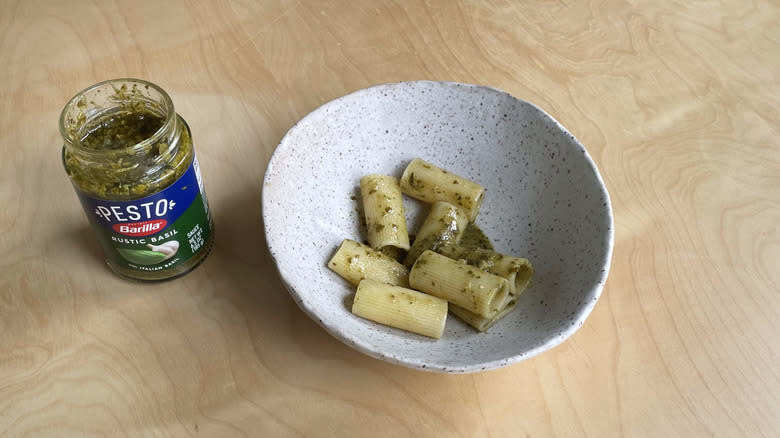
Barilla, one of the largest pasta businesses in the world, is perhaps best known for the sea of blue-boxed dried pasta that populates most grocery store shelves. It's expected that they'd be into the sauce game, too.
We got excited when we saw that the first ingredient in this pesto was basil. But, we were swiftly disappointed to find out the second was sunflower oil. The neutral fat does little here for the flavor, as the pesto is also bracingly acidic and briny from the preservatives. It gives this sauce the taste of a fatty green olive, which isn't altogether unpleasant -- but simply doesn't taste like pesto.
The color of this pesto is pleasant enough, with more vibrancy than some of our lower-ranked brands. Regardless, this jar still has a potent basil aroma. Barilla's pesto was the only one we sampled that included spinach, which we assumed was for color and cost savings. In addition to this leafy green, this brand includes a few other ingredients we'd rather not find in even our jarred pesto, like stabilizers, preservatives, and flavor enhancers (potato flakes, lactic acid, and yeast extract, respectively).
7. Filippo Berio Classic Pesto
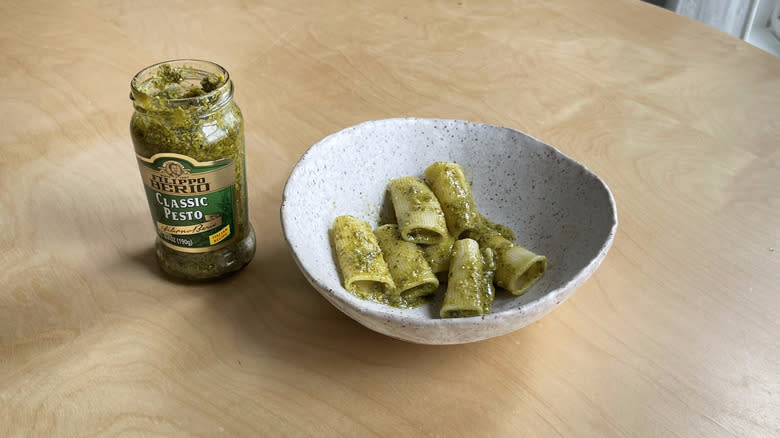
You'd think that a simple way to distinguish good pesto from mediocre brands would be to purchase a jar (which should list extra-virgin olive oil as a primary ingredient) from an olive oil manufacturer like Filippo Berio. We were disappointed to find out that this pesto was cut with cheap sunflower oil. It may not be the most expensive option on our list, but the inclusion of sunflower oil knocks it down a few pegs.
The basil flavor here is bitter, like sucking on a raw basil leaf, but the texture is superb. Even when eaten straight from the jar, this pesto has a smooth, almost pasty mouthfeel. We like a pesto that, when mixed with a bit of pasta cooking water, transforms into a rather luscious, clingy sauce. Here, there were no hapless chunks of nuts or cheese to get in our way, and the smooth green sauce coated each noodle generously.
True to pesto's lineage, Filippo Berio makes this pesto sauce in Liguria with basil grown in the region. This sauce is also made with Italian cheese, including Grana Padano and Pecorino Romano -- both of which were labeled as PDO (Protected Designation of Origin). This title indicates a regional product produced with traditional methods and local ingredients -- and it makes us feel that this product is more authentic than other pesto brands we sampled.
6. Alessi Pesto
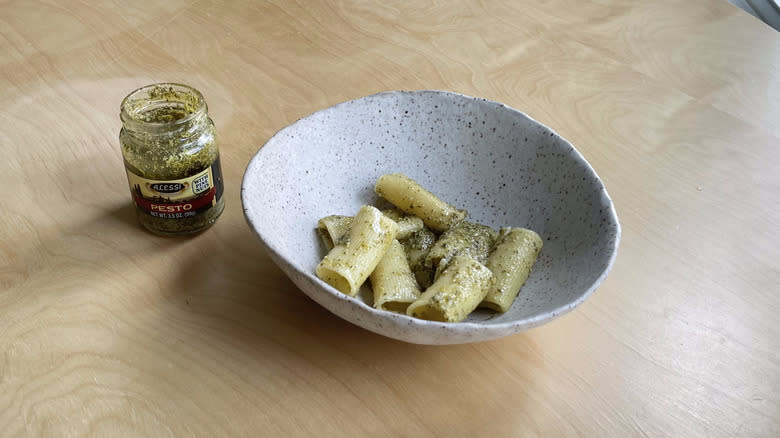
There is something different about Alessi's pesto -- and it's not just the petite 3.5-ounce jar that just barely coats a pound of pasta. At first glance, it looks like all the other pestos with its finely ground consistency and its murky green color.
But once you taste it, you know something else is going on entirely. You begin to remember all the scarpettas of your past and the times when you sopped up the oily dregs of a meal's end with a crusty slice of bread. Suddenly, it's like the sun peeking through the clouds. You remember the flavor of olive oil — its fruitiness and its bitterness. You remember what pesto can taste like and what pesto should taste.
Yes, the sauce's color isn't vibrant, nor are the flecks of basil exceptionally large and becoming, but the ingredients, including Pecorino Romano cheese, are as close to traditional as we've gotten thus far, so we'll give Alessi some credit. The brand's exclusive use of olive oil gives this pesto a true Genovese taste.
This pesto also includes the brand's proprietary white balsamic vinegar. Unfortunately, the acidity brings us back down to earth, reminding us that this is still far from a homemade pesto. It dissolves the image of grinding the ingredients with a mortar and pestle on a sunlit stoop in Genoa -- which is nothing short of unfortunate.
5. Trader Joe's Basil Pesto Sauce
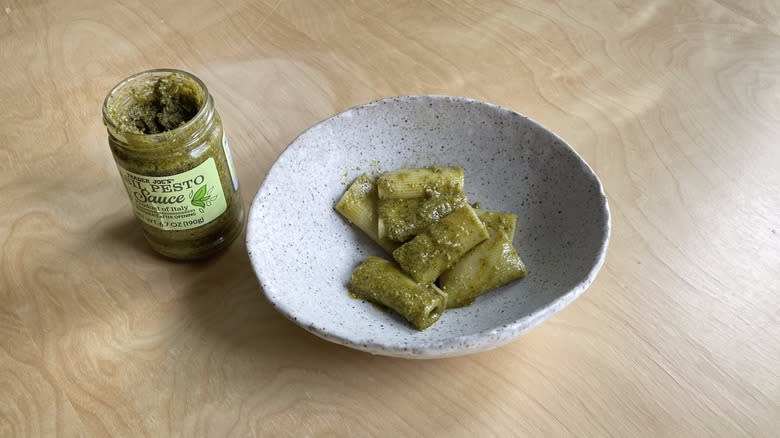
We were curious to see how a brand like Trader Joe's would interpret such a traditional sauce. Would they go rogue by subbing cheddar for Parmigiano Reggiano? Or substitute pine nuts for something nuttier and wackier? We were surprised to find out then that the brand took a different approach. It made the pesto as true to the original Genovese recipe as possible, going so far as to produce it in Italy.
This pesto is shockingly expensive — it retails on Amazon for almost twice the price of other options on this list. This may have been because a third-party retailer was selling it and because it's made with quality ingredients like basil, olive oil, and a blend of imported Italian cheeses.
Cornstarch is used to stabilize this mixture, which is likely why the oil barely separates and requires minimal pre-mixing. While the brand labels this a sauce, it's thick enough to use as a spread. We thought this sauce had a good amount of saltiness, which tempered the sourness coming from the citric acid. But, it may be a bit foolhardy to enjoy on a slice of pane tostato.
4. Polli Traditional Basil Pesto Sauce
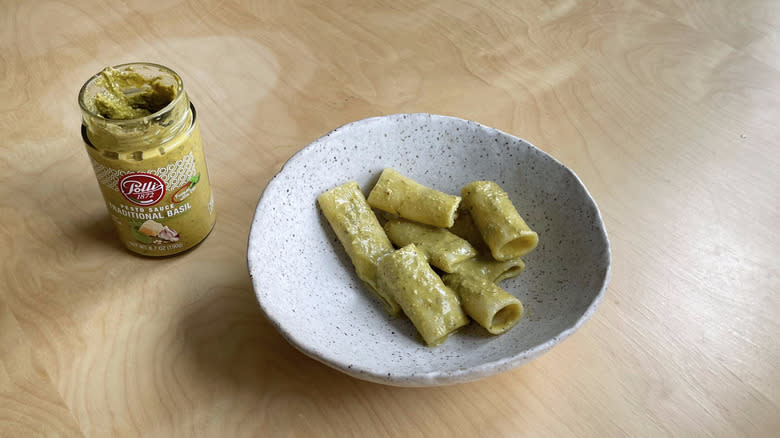
We didn't want to like Polli because it looks nothing like the Genovese basil pesto we know and love. And it contains none of the tell-tale signs that it's made with fresh herbs; the color isn't vibrant, and there are no discernible clumps of basil. This led us to scratch our heads and ask whether or not this is, in fact, a pesto or a nut butter. We were even more convinced of the latter when we saw it contained peanuts.
But we live and die by the second bite rule: If you instinctively go back for a second bite, the dish is inarguably delicious — and Polli's pesto passed this test. It's salty and savory, reminiscent of the crystalline parts of Parmigiano Reggiano or the dried clumps of cheese powder in poorly-mixed boxed mac and cheese. To give it this umami character, Polli uses a mix of Grana Padano and Pecorino Romano cheese.
Pasta novices will rejoice at how the oil doesn't split from this pesto, even with minimal agitation from our leftover pasta water. You could do the Dairy Queen Blizzard test with this one and try flipping it over. After all, it's thick, and the opaque color reads more like gelato than pesto. To achieve such creaminess, the first ingredient here is not basil but sunflower oil. And though it may not look pretty in the bowl, it's surprisingly addictive — one might even say engineered to be.
3. Barilla Creamy Genovese Pesto
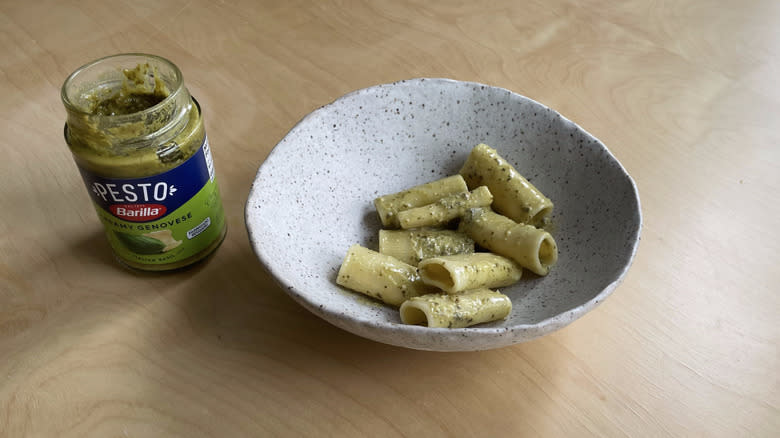
Diners like "creamy." A Google search for "creamy recipes" yields over 300,000,000 search results (about twice as many as "crunchy recipes"). And while Barilla's creamy Genovese pesto isn't quite as luscious as our lower-ranked brands, it still scratches that itch for a sauce that's not quite a cream sauce but also not quite an oil-based sauce. Yet, there are also flecks of basil to remind you that this is, in fact, pesto.
Don't be fooled by the seductive connotation of the word "creamy" on the label. This pesto isn't creamy in the traditional sense of the word. As was the case with Polli, the first ingredient here is not basil, like other non-creamy brands, but sunflower oil. Perhaps this shortcut is what allows the brand to splurge on its impressive cheese selection, including PDO Parmigiano Reggiano, which adds an expected saltiness.
But what is sugar doing in here? It doesn't enhance or temper the bitterness of the basil but instead gives it the flavor of starchy springtime peas. This flavor is great for a pea pesto but not great for a basil one. The sweetness and smooth texture make us think that this sauce would be a palatable option for children -- but it doesn't satisfy our craving for a mature, balanced sauce.
2. Seggiano Fresh Genovese Basil Pesto
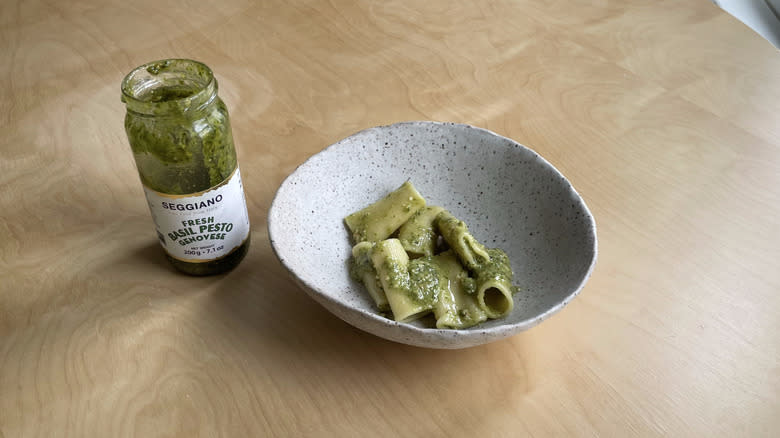
Ahh, Seggiano. This sauce is bright green and vibrant -- like the color of money. While the hue is dreamy, the price is anything but. It was, by far, the most expensive brand we sampled. Why is that? For starters, this pesto is made from Ligurian basil, though it's produced in Piemonte -- another region of the country entirely. Each ingredient is sourced from a high-quality producer within the country, which is a nod to Seggiano's commitment to authentic, great flavors. And the ingredient list is dead simple; it only includes extra-virgin olive oil, cashew nuts, basil, sea salt, and pine nuts. There are no stabilizers or acidifiers used.
We've seen this ingredient wizardry before in some of our low-ranked products. But, Seggiano is notably more homemade-tasting. It's a platonic ideal for what pesto should be like. It genuinely tastes like the generous byproduct of an overflowing terracotta pot. The secret lies in the way the pesto is processed. It's unpasteurized, which keeps the basil flavor at the forefront.
The omission of cheese here is a plot twist, especially coming from a brand that is so bent on authenticity. But, this allows the brand to market the product as vegan -- and you can always grate a little sprinkle of cheese on top. We even thought there was enough salt to compensate for the lack of cheese.
1. DeLallo Traditional Basil Simply Pesto
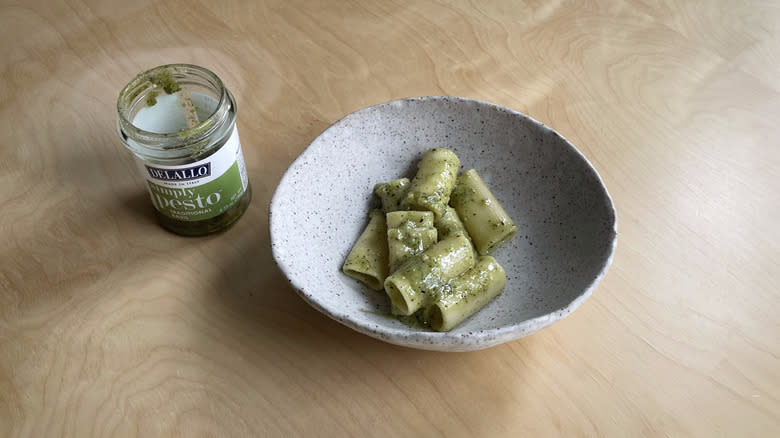
And after all of this, we're still left asking: Could there be a store-bought, jarred basil pesto brand that's both made with high-quality ingredients and affordable? Like, weeknight affordable. Keep stockpiled in your larder affordable. We were surprised to find that DeLallo did just that. It's noticeably bright green — an eye-catching hue we saw only with Seggiano. Up until this point, our lineup has been filled with cheap oils, domestic cheeses, and acidifying agents. But the ingredients in DeLallo's pesto are simple and roughly the same as Seggiano's: handpicked Ligurian basil, olive oil, cashew and pine nuts, plus Parmigiano Reggiano and Pecorino Romano.
So how can this pesto cost almost a dollar less than Seggiano's? This might be due to its texture. DeLallo's contained little fibrous basil and was instead mostly olive oil. In fact, the amount of herbs was just enough to constitute it as a pesto rather than an infused oil. This made for a sauce that coated all of the noodles and gave us the satisfying mouthfeel that the other brands missed.
Methodology
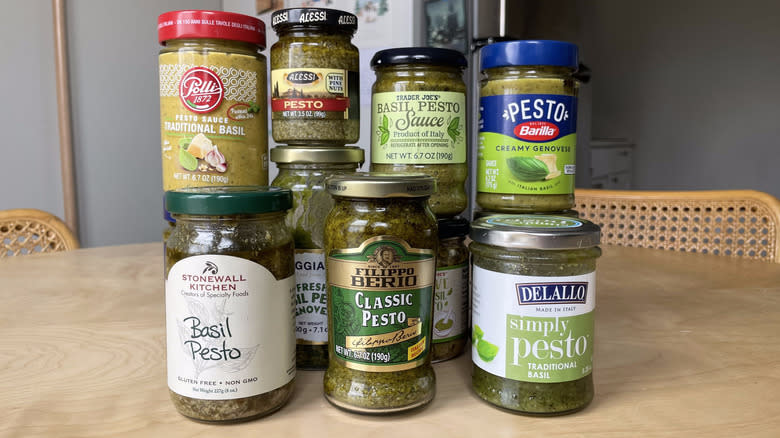
With the right brand, pesto is delicious enough to enjoy by the spoonful — though we don't advise it. We evaluated each brand's version of pesto based on texture, creaminess, herbal qualities of the basil, and cheesy notes.
Some of the brands above, like Classico, note that this Italian condiment can be enjoyed as a sauce or a spread. Still, pesto will forever be synonymous with pasta, and so our taste-test held fast to tradition. We chose to test our pestos with rigatoni, a short shape, to evaluate how well the sauce clung to the noodles. We mixed each pesto with a bit of starchy cooking water to help it adhere to the noodles. Then, we gave it a taste while still warm, because, as they say in the Italian kitchen, pasta waits for no one. No additional garnishes, like cheese, black pepper, or salt were used.
Read the original article on Tasting Table

